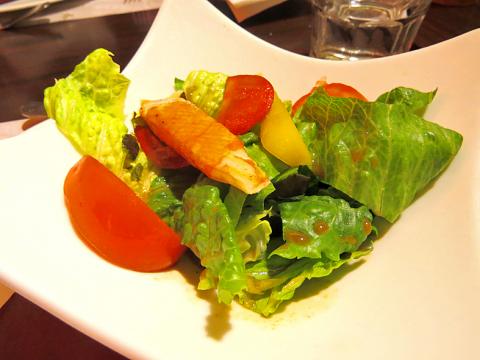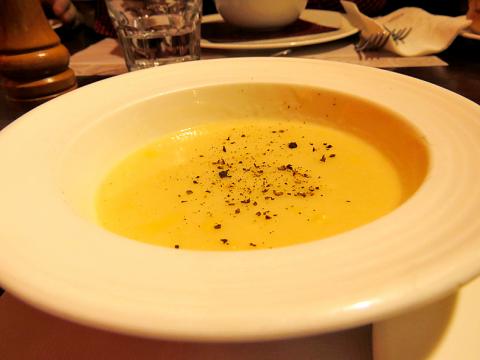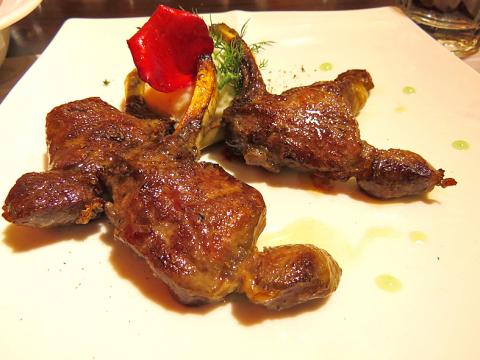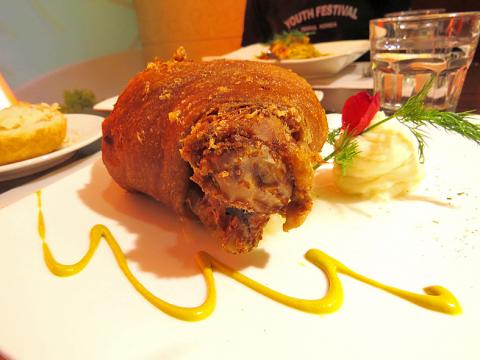Gilley’s Restaurant (天母盛鑫) opened in 1979 in Tienmu, where it made a local name on German pork knuckle and glossy rib-eye steaks eaten with a pinch of salt and nothing else.
Since then, the European-style restaurant has moved to Zhongshan N Rd (中山北路) in Shilin and opened a new location inside the Miramar Entertainment Park.
The Miramar location is the smaller of the two. Its compact single room seats about 40 at slender wooden tables and chairs covered in a crimson felt. This decor creates an elegant salon look, interrupted by an enlarged photograph of a pork knuckle and some large clownfish-colored fluorescent lamps arranged at the very back in the shape of Xs. The lamps glow softly and oddly, and from the fifth-floor shopping concourse looking in, the restaurant is a big weird box of light.

Photo: Enru Lin, Taipei Times
The menu here offers mainly set meals, plus a few appetizers and soup items a la carte. Sets range from NT$380 (vegetable risotto with cream sauce) to NT$780 (roasted steak with crayfish), and include bread, salad, an appetizer, dessert and a beverage.
First from the kitchen is a hot puffy roll meant to be eaten with garlic butter sitting on the table in a ramekin. The butter comes out thick on the knife but melts easily, and the flavor is surprising, herblike before rounding out into a light sweetness.
Next up is a romaine salad tossed in a tart vinegar dressing; and then soup, a sturdy bowl of corn chowder that’s an interpretation of western corn chowder featuring Hokkaido cream (NT$120 a la carte).

Photo: Enru Lin, Taipei Times
The appetizer arrives in three parts: From left to right on the plate, there’s a whorl of goose liver mousse on a one-bite slice on flaky toast; a slightly warm, subtly smoked frisson of Norwegian smoked salmon; and a dish filled with a bit of chewy snail in tomato sauce and melted mozzarella. They look unappetizing and gaudy on the plate, but the flavors go together like a deconstructed pizza.
Gilley’s real standouts are meats prepared simply but remarkably. German pork knuckle with in-house sauerkraut (NT$680), one of Gilley’s enduring trophy items, comes out on the plate as a gorgeous golden parcel with no excess fat. This is a particularly large pork knuckle that’s baked and then flash-fried into a golden crisp. The exterior is rough and crispy, and the inside is juicy, with a blooming porkiness and soft texture that falls apart under the knife.
The Frenched lamb shoulder rack (NT$680) is also a good cut prepared in an extraordinary way. Each order is two ribs that come with a small side of mashed potatoes and thick drops of mint sauce arranged in a horseshoe formation on the plate. When they arrive, they are well-rested and warm, not hot, rimmed with only a slight strip of fat and browned beautifully with no carbonization on top.

Photo: Enru Lin, Taipei Times
Beverages include juices, coffee and teas like chrysanthemum (NT$120) and a fruity Lady Grey (NT$120). There’s Heineken and Corona, but no wine list. Upon request, waitstaff push out a cart and can help pair meats with white and red wines ranging from NT$550 to NT$1,100.

Photo: Enru Lin, Taipei Times

Photo: Enru Lin, Taipei Times

May 11 to May 18 The original Taichung Railway Station was long thought to have been completely razed. Opening on May 15, 1905, the one-story wooden structure soon outgrew its purpose and was replaced in 1917 by a grandiose, Western-style station. During construction on the third-generation station in 2017, workers discovered the service pit for the original station’s locomotive depot. A year later, a small wooden building on site was determined by historians to be the first stationmaster’s office, built around 1908. With these findings, the Taichung Railway Station Cultural Park now boasts that it has

Wooden houses wedged between concrete, crumbling brick facades with roofs gaping to the sky, and tiled art deco buildings down narrow alleyways: Taichung Central District’s (中區) aging architecture reveals both the allure and reality of the old downtown. From Indigenous settlement to capital under Qing Dynasty rule through to Japanese colonization, Taichung’s Central District holds a long and layered history. The bygone beauty of its streets once earned it the nickname “Little Kyoto.” Since the late eighties, however, the shifting of economic and government centers westward signaled a gradual decline in the area’s evolving fortunes. With the regeneration of the once

In February of this year the Taipei Times reported on the visit of Lienchiang County Commissioner Wang Chung-ming (王忠銘) of the Chinese Nationalist Party (KMT) and a delegation to a lantern festival in Fuzhou’s Mawei District in Fujian Province. “Today, Mawei and Matsu jointly marked the lantern festival,” Wang was quoted as saying, adding that both sides “being of one people,” is a cause for joy. Wang was passing around a common claim of officials of the People’s Republic of China (PRC) and the PRC’s allies and supporters in Taiwan — KMT and the Taiwan People’s Party — and elsewhere: Taiwan and

Even by the standards of Ukraine’s International Legion, which comprises volunteers from over 55 countries, Han has an unusual backstory. Born in Taichung, he grew up in Costa Rica — then one of Taiwan’s diplomatic allies — where a relative worked for the embassy. After attending an American international high school in San Jose, Costa Rica’s capital, Han — who prefers to use only his given name for OPSEC (operations security) reasons — moved to the US in his teens. He attended Penn State University before returning to Taiwan to work in the semiconductor industry in Kaohsiung, where he